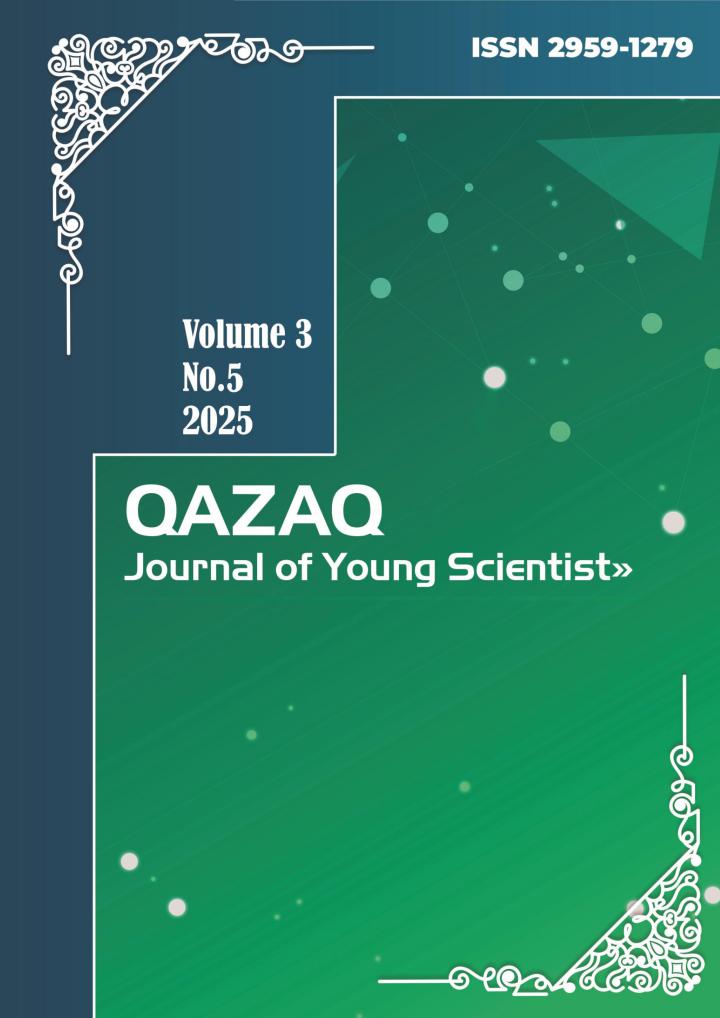ЗИЯНДЫ БАҒДАРЛАМАЛЫҚ ЖІКТЕУ ЖӘНЕ ТАЛДАУ ҮШІН НЕЙРЛІК ЖЕЛІЛЕРДІ ҚОЛДАНУ
Main Article Content
Аңдатпа
Мақалада вирустарды, трояндық аттарды, руткиттерді, шпиондық бағдарламаларды және киберқауіптердің басқа түрлерін қоса алғанда, зиянды бағдарламаларды автоматтандырылған жіктеу және талдау үшін нейрондық желілерді пайдаланудың заманауи әдістері талқыланады. Зиянды бағдарламалардың эволюциясына бейімделуге және жаңа, бұрын белгісіз қауіптерді анықтауға қабілетті интеллектуалды жүйелерді дамытуға ерекше назар аударылады. Зерттеу барысында сигнатуралық және эвристикалық талдау сияқты зиянды бағдарламаларды анықтаудың дәстүрлі әдістеріне, сондай-ақ полиморфты және метаморфтық вирустардың пайда болуы жағдайында олардың шектеулеріне салыстырмалы талдау жүргізілді. Әр түрлі терең нейрондық желі архитектураларының рөлі талқыланады, соның ішінде файлдардың екілік көрсетілімдерін талдауға арналған конволюционды желілер (CNN), қайталанатын желілер (RNN) және кодтағы дәйекті үлгілерді анықтауға арналған трансформаторлар және ықтимал зиянды бағдарлама мутацияларын болжауға арналған генеративті модельдер. Зерттеудің практикалық бөлігінде зиянды бағдарламаларды статикалық және динамикалық талдау тәсілдерін біріктіретін нейрондық желілер ансамблі негізінде машиналық оқыту моделі әзірленді. Нақты деректер жиынын пайдаланатын эксперименттер ұсынылған тәсіл талдаудың дәлдігі мен жылдамдығы бойынша дәстүрлі анықтау әдістерінен асып түсетінін көрсетті. Алынған нәтижелер ақпараттық жүйелердің қауіпсіздік деңгейін айтарлықтай арттыруға және зиянкестердің сәтті шабуылдарының ықтималдығын азайтуға мүмкіндік беретін автоматтандырылған киберқорғаныс үшін нейрондық желі әдістерін қолданудың әлеуетін көрсетеді.
Article Details
##submission.citations##
Aitchanov B., Bapiev I. Development of a procedure for determining the expected output signal of a neural network model for recognizing cyber-attacks [Electronic resource / B. Aitchanov, I. Bapiev // Information technologies in education]. International Journal of Applied and basic research, 2017; pp. 5: 8-11.
Korchenko A., Tereikovsky I., Karpinsky N., Tynimbayev S. Neural network models, methods and tools for assessing the security parameters of internet-oriented information systems // Neural network models, methods and tools for assessing the security parameters of funeral information systems. Kiev: Tov "Nashformat", 2016.
Tereikovskaya L. A., Tereikovsky I. A. Application of experience in the development of a neural network model for recognizing phonemes in a speech signal [text] / / material of the II international scientific and Practical Conference "Information and telecommunications technologies: education, science and practice", Almaty, Kazakhstan, 2015, pp. 258-261.
Akhmetov B. B., Korchenko A. G., Tereykovsky I. A., Alibieva Zh. M., Bapiev I. M. Parameters for assessing the effectiveness of neural networks for recognizing cyber-attacks on network resources of Information Systems. Reports of the National Academy of Sciences of the Republic of Kazakhstan, 2017; pp. 2: 28-37.
Bapiev I. M., Akhmetov B. S., Korchenko A. G. and Tereykovsky I. A. The use of a neural network with radial basis functions for the recognition of scenario viruses // applied mathematics and Computer Science II international scientific and practical conference "actual problems of cybersecurity and Information Protection", Kiev, Ukraine, 2016, pp. 21-24.
Grishin A.V. Neural network technologies in the tasks of detecting computer attacks. Information technology and computer systems, 2011; 1: 53-64 pp.
Yuyanova Yu. An analysis of the problem and prospects of creating an intelligent system for detecting and preventing network attacks on cloud computing. [Analysis of the problems and capabilities of intelligent system development to detect and prevent network attacks on cloud computing]. Software systems: theory and application, 2011; pp. 4: 17-31.
Mustafaev A. G. Neural system for detecting computer attacks based on the analysis of network traffic. Neural system for detecting attacks based on network traffic. Security issues, 2016; 2: pp. 1-7.
R. Vinod Kumar and K. Kishor Kumar Exploiting content management system vulnerabilities to initiate large-scale cyber-attacks, International Journal of construction and Technology, 8 (10), 2017, pp. 1381-1395.
Prof. Abhinav V. Deshpande. Implementing a reliable cybersecurity system by preventing intrusion by outsiders through the development of a new and effective cybersecurity policy. International Journal of Information Technology and information management systems (IJITMIS), 6 (2), 2015, 01-10 pp.
Al-Saadi M. S. M. & Hamze K. (2024). Testing wireless penetration networks using artificial intelligence: improving security vulnerability detection using CNN models. International research journal innovations in engineering and technology. https://doi.org/10.47001/irjiet/2024.805034.
Chen Z., Kang F., Xiong X., and Shu X. (2024). Survey on penetration path planning in automated penetration testing. Applied Sciences, 14 (18), 8355. https://doi.org/10.3390/app14188355.
Minich A., Jovanovich, L., Buchanon N., Stoyan S., Kovich C., Spalevich P., Stoyan R. (2023) The use of repetitive neural networks to detect abnormalities in the data of electrocardiogram sensors. Sensors (Basel, Switzerland), 2023. https://doi.org/10.3390/s23249878.
Vaughn, D. O., Chan, Yu. N. and Lee S. (2023). PlausMal-GAN: potential malware training based on generative adversary networks for similar, 11, 82-94. https://doi.org/10.1109/TETC.2022.3170544.
